Hydroponics Grow Tent Setup: A Comprehensive Guide

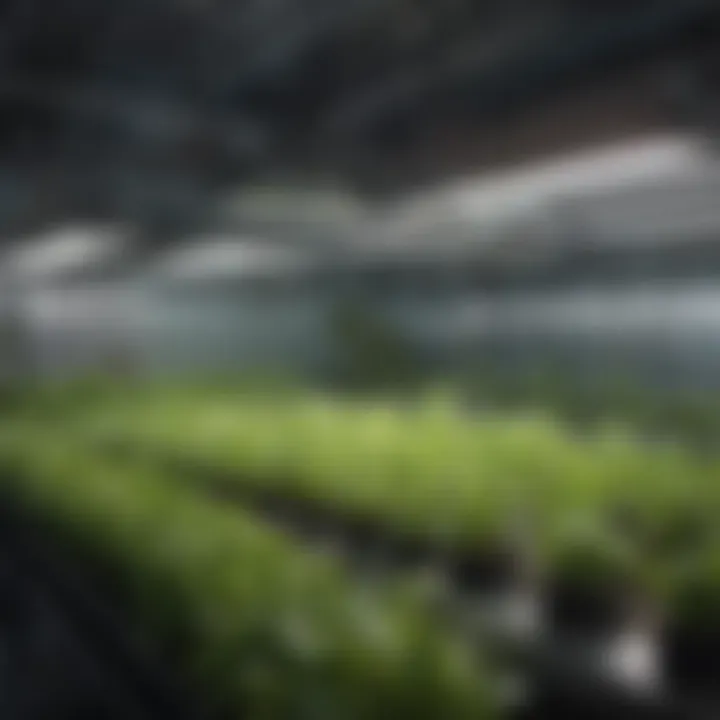
Intro
Hydroponics has been gaining traction in the agricultural realm, particularly as a method for growing plants in a soil-less environment. This technique allows for efficient use of space and resources while ultimately pushing the boundaries of what’s possible in terms of growth rates and yields. Setting up a hydroponics grow tent is an ideal way to experiment with manageability, controlling every variable involved in plant growth.
This guide will delve into the critical elements of hydroponics grow tent setup, emphasizing its relevance in this age of sustainability and innovation. From selecting the right lighting to understanding ventilation systems, we will cover all the bases to help you establish a flourishing indoor garden.
Overview of the Topic
Definition and Importance
Hydroponics is a method where plants are grown without soil, using nutrient-rich solutions. This approach is pivotal for those who wish to cultivate crops in environments where traditional farming may not be feasible. It caters to urban populations, farmers seeking to maximize yields in small spaces, and anyone wanting to harness the benefits of year-round growing cycles.
The importance of hydroponics lies not only in increasing agricultural output but also in reducing the carbon footprint associated with transportation and conventional farming methods. It advocates resource conservation, utilizing water and nutrients far more efficiently than traditional practices.
Current Trends
Several trends are shaping the future of hydroponics.
- Integration with Smart Technology: Many hydroponic setups are being enhanced with IoT devices, allowing growers to monitor conditions remotely and automate processes. This further optimizes plant growth.
- Sustainable Practices: Urban farming is on the rise, and with it comes the use of sustainable materials and methods. Growers are increasingly turning to organic nutrients and energy-efficient systems to minimize impact on the environment.
- Vertical Farming: The trend of stacking plants in a vertical arrangement is becoming popular, especially in places with limited growing space. It enables urban farmers or hobbyists to maximize their yield without taking up too much land.
Key Techniques and Practices
Step-by-Step Guide
Setting up a hydroponics grow tent involves several steps:
- Select Your Tent: Choose a size that will fit your space and your intended plants. A larger tent allows for more plants, while a smaller tent is perfect for beginners.
- Install Lighting: Depending on the type of plants you're growing, choose the appropriate lighting, such as LED or HID lights. Keep them at the right distance to prevent burning the plants.
- Choose the Right System: Options include deep water culture, nutrient film technique, or aeroponics, among others. Selecting the right system depends on your goals and the plants you wish to cultivate.
- Set Up Nutrient Delivery System: Ensure that you have a reservoir filled with water and the necessary nutrients mixed in. Regularly check the pH level to keep it optimal for plant growth.
- Ensure Proper Ventilation: A circulation fan keeps air moving and helps maintain humidity levels. Consider adding an exhaust fan for heat management.
Tools and Equipment Needed
You will need a variety of tools and equipment to make your setup a success:
- Grow tent (size depends on your space)
- Hydroponic system (NFT, DWC, etc.)
- Lighting system (LED or HID)
- Nutrient solutions and pH testing kit
- Fans for ventilation
- Thermometer and hygrometer to monitor conditions
- Reflective material to enhance light efficiency
Challenges and Solutions
Common Obstacles
While setting up hydroponics, challenges may crop up:
- Pest Management: Indoor environments can still attract pests like aphids and spider mites.
- Nutrient Imbalance: Inaccurate dosing can lead to deficiencies or toxic build-up.
- Temperature Regulation: Fluctuations in temperature and humidity can stress plants.
Innovative Solutions
To navigate these obstacles, consider the following solutions:
- Utilize insect repellents or beneficial insects to control pest populations.
- Regularly monitor nutrient levels and adjust solutions as necessary to maintain balance.
- Implement thermostats or humidistats to gain better control over the growing environment.
Hydroponics represents both a challenge and an opportunity for those passionate about redefining agriculture in their own spaces.
Understanding these facets ultimately equips enthusiasts and farmers alike with robust knowledge to take the plunge into hydroponics, ensuring they nurture their plants efficiently and sustainably.
Understanding Hydroponics
In the realm of modern agriculture, hydroponics emerges as a significant player, reshaping how plants are cultivated and nurtured. This innovative method enables growth without soil, using nutrient-rich water solutions instead. The importance of understanding hydroponics lies not just in the technique itself but in its potential to revolutionize food production in various contexts. Whether one is a hobbyist aiming for homegrown greens or a commercial farmer looking to maximize yield, comprehending the core principles is essential.
Definition and Overview
Simply put, hydroponics is the process of growing plants in a water-based, nutrient-rich solution, bypassing the traditional soil dependency. This method can be traced back centuries but has gained traction in recent years due to its efficiency and adaptability. Hydroponics is more than a gardening technique; it's a sustainable approach that addresses several challenges in agriculture today. For instance, in urban settings where space is limited, hydroponics allows individuals to cultivate crops indoors or in confined areas. Noteworthy is that crops can be grown with significantly less water compared to conventional farming, presenting a viable solution to water scarcity issues.
Advantages Over Traditional Farming
Hydroponics brings forth numerous advantages compared to traditional soil-based agriculture:
- Space Efficiency: Hydroponics setups can be complex, but they often utilize space more efficiently, making them suitable for urban environments.
- Faster Growth Rates: Because plants receive direct access to nutrients, they usually grow faster than in soil. Some crops can double their growth speed, which is quite the boon for farmers.
- Reduced Pest Problems: Without the soil, many common pests and diseases are either eliminated or greatly reduced, allowing for healthier plants and less reliance on pesticides.
- Water Conservation: Hydroponics systems typically use around 10% of the water required for soil cultivation, offering a sustainable edge in areas where water is a precious resource.
"Hydroponics is not just a growing trend—it's a glimpse into the future of agriculture itself."
Types of Hydroponic Systems
Hydroponics isn't one-size-fits-all; several systems cater to different needs and environments. Here are some notable types:
- Deep Water Culture (DWC): Plants float on a nutrient-rich solution, ensuring their roots are submerged and well-fed. This method is straightforward and often favored for beginners.
- Nutrient Film Technique (NFT): A thin film of nutrient solution continuously flows over the roots, which minimizes water usage while providing ample nourishment.
- Ebb and Flow (Flood and Drain): This system periodically floods the grow tray with nutrient solution, then drains it away. It’s effective but requires some careful monitoring to avoid over-saturation.
- Aeroponics: Here, plants hang in a chamber where their roots are fogged with a nutrient mist, allowing for maximum oxygen exposure. This method can further boost growth rates but demands greater technical expertise.
- Wicking Systems: Simplistic in design, they use capillary action to draw nutrient solution to the roots. This method is very basic and helps one get started with hydroponics.
Each system has its pros and cons, chosen based on factors like available space, plant types, and grower expertise. Understanding these systems is crucial for anyone considering a venture into hydroponics.
Defining the Grow Tent
Defining a grow tent holds significant importance in the context of hydroponic gardening. This section serves as a foundation for understanding not just what a grow tent is, but also its role in cultivating plants in a controlled environment. A grow tent acts like a mini greenhouse, providing farmers and enthusiasts alike with the ability to create the optimal conditions for plant growth, regardless of external weather conditions.
When starting out in hydroponics, a grow tent is often the first major investment made by both amateur and professional growers. It is essential as it offers a designated area that can be easily managed. Grow tents help in minimizing potential ailments that come from outdoor gardening, like pests and unpredictable climates. Thus, comprehending the grow tent's characteristics can aid in maximizing crop yields while conserving resources.
Purpose of a Grow Tent
The core purpose of a grow tent is to create a controlled environment for growing plants. By regulating variables like temperature, humidity, and light exposure, growers can ensure their plants thrive regardless of the season. A grow tent contains reflective materials that enhance light exposure and efficiency, allowing for improved photosynthesis. Thus, a grow tent not only optimizes growth rates but can also significantly reduce energy costs associated with lighting and heating.
Moreover, grow tents facilitate easier monitoring of plant health. The compact space enables quick adjustments to environmental factors, creating an agile growing operation. As a result, many hydroponic setups begin with the selection of an appropriate grow tent tailored to specific plant needs.
Choosing the Right Size
Choosing the right size for a grow tent is not merely a matter of aesthetics; it's a crucial aspect that directly influences plant health and yield. The dimensions of the tent should relate to the number of plants being grown and the hydroponic system employed. A larger tent accommodates more significant setups, but it's vital to avoid overcrowding, as this can lead to poor air circulation and light distribution.
To determine the optimal size, consider the following:
- Number of Plants: The more plants, the larger the tent needed. Each plant requires a specific amount of space to grow.
- Type of Hydroponic System: Systems like deep water culture might require more vertical space, while others like a vertical farm set-up demand horizontal room.
- Accessibility: Ensure there is enough space to access all plants for maintenance, pruning, or harvesting.
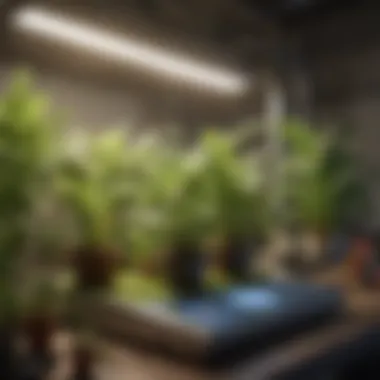
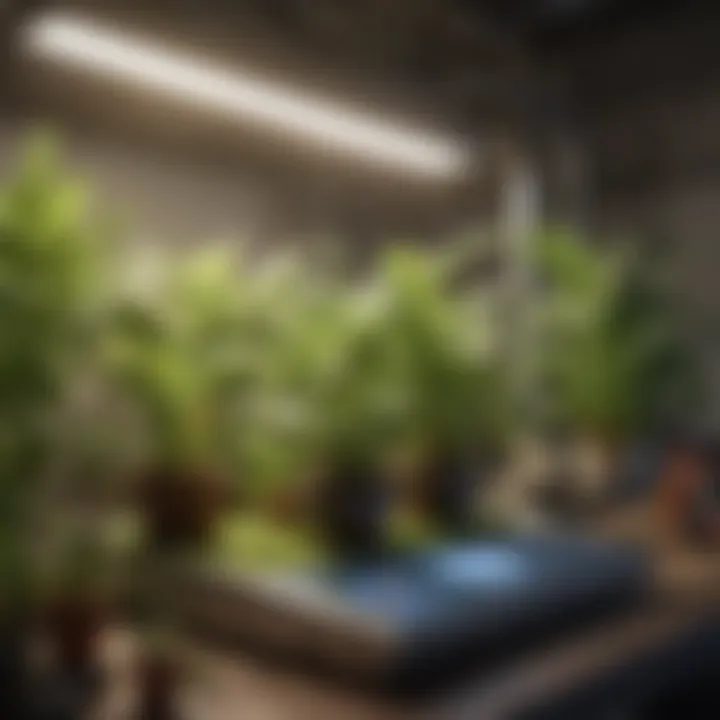
Materials and Construction
The materials and construction of a grow tent play an essential role in both durability and effectiveness. High-quality grow tents are usually lined with mylar or other reflective materials that maximize light efficiency. The outer layer should be made from water-resistant and tear-resistant fabric, ensuring longevity.
When considering construction, certain aspects are crucial:
- Frame Structure: Opt for a sturdy frame that can support the weight of lighting and other equipment.
- Zipper Quality: A well-constructed zipper is important for ease of access and maintaining the tent's seal against light leaks or pests.
- Ventilation Ports: Ensure the tent includes multiple ventilation ports to allow for proper airflow without compromising the tent's environmental integrity.
In summary, understanding the grow tent is fundamental for anyone interested in hydroponic gardening. It sets the stage for developing a cultivation space that is efficient, manageable, and conducive to healthy plant growth.
Essential Equipment for Setup
When it comes to hydroponics, the role of essential equipment cannot be overstated. This equipment isn’t merely supplementary; it forms the backbone of a successful grow tent setup. Selecting the right tools directly influences the growth rate, health, and yield of your plants. Having the proper gear allows for better control over the environment, ultimately leading to optimal plant growth.
Lighting Options
Lighting plays a crucial role in mimicking sunlight, which is vital for photosynthesis and healthy plant growth. Different lighting options offer various benefits, each suited to different types of crops and conditions.
LEDs
Now, if you’re looking to save energy while providing your plants with the light they crave, LEDs are quite popular.
Key Characteristic: Their energy efficiency is stellar. They consume less power compared to traditional bulbs and last longer.
Unique Feature: One of the standout benefits of LEDs is the ability to customize their light spectrum. This means you can tailor the light to assist plants at various growth stages.
If you want to promote blooming, you can adjust the spectrum accordingly. However, the initial investment might seem steep compared to other options; the long-term savings on your energy bill can really make a dent in those upfront costs.
HID Lights
HID lights, or High-Intensity Discharge lights, are another sturdy option. They are renowned for producing high lumens and effectively covering larger areas.
Key Characteristic: Their intensity is unmatched, which many growers appreciate.
Unique Feature: They typically come in two types: Metal Halide (MH) for vegetative growth and High-Pressure Sodium (HPS) for flowering. This dual functionality makes them versatile choices.
However, one must also consider heat production. HID lights can generate quite a bit of heat, which leads to additional cooling requirements.
Fluorescent Tubes
Fluorescent lights come with their own set of advantages. These are particularly useful for seedlings and smaller plants.
Key Characteristic: They are relatively inexpensive and consume less energy.
Unique Feature: The low heat output means you won’t have to worry about scorching your more delicate seedlings. This makes them an excellent choice for initial growth stages.
On the downside, they might not be enough for larger plants or those that require high light levels.
Ventilation Systems
Ventilation is another key component in maintaining a healthy hydroponic environment. Proper air circulation can mean the difference between thriving plants and those that struggle.
Fans
When it comes to ventilation, fans are the workhorses. They help circulate air, ensuring that temperatures and humidity levels are kept constant.
Key Characteristic: They come in various sizes and styles, whether oscillating or stationary.
Unique Feature: The ability to adjust fan speed is crucial; some plants need a gentle breeze while others can handle more turbulence. However, too much airflow can stress plants, so finding that sweet spot is key.
Filters
Air quality can seriously impact plant health, and this is where filters come into play. These devices help remove odors as well as particulates out of the air.
Key Characteristic: Carbon filters are particularly effective in neutralizing odors.
Unique Feature: They should last quite a while, but maintenance is necessary to keep them effective. A clogged filter can lead to unwanted scents and lower-air quality.
Ducting
Ducting serves as the arteries of your ventilation system, channeling air where it needs to go.
Key Characteristic: Proper ducting can significantly improve airflow efficiency.
Unique Feature: Insulated ducting options help mitigate noise and temperature loss. Poor setup can result in heat pockets or unwanted pressure drops, which can be detrimental to your plants.
Hydroponic System Components
Now let's delve into some specific hydroponic system components that are essential for a successful setup.
Reservoirs
Reservoirs are your plant's lifeline in a hydroponic system, holding the nutrient solution.
Key Characteristic: They can be made from various materials, and size varies based on the scale of your operation.
Unique Feature: Some reservoirs come equipped with built-in indicators for monitoring nutrient levels. Keeping an eye on this is important to avoid deficiencies or toxic buildups.
Pumps
Pumps are critical in circulating the nutrient solution, ensuring that all plants receive adequate food and water.
Key Characteristic: They vary in capacity and type, including submersible and inline.
Unique Feature: Some pumps offer adjustable flow rates, giving you more control over how much nutrient solution reaches your plants. However, be cautious: a pump that’s too powerful can lead to over-saturation.
Nutrient Delivery Systems
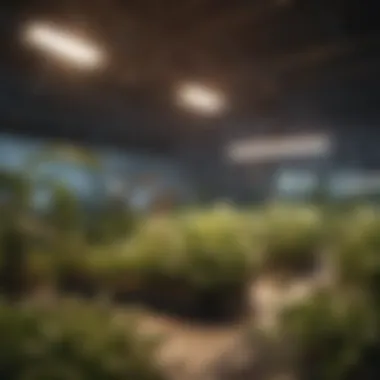
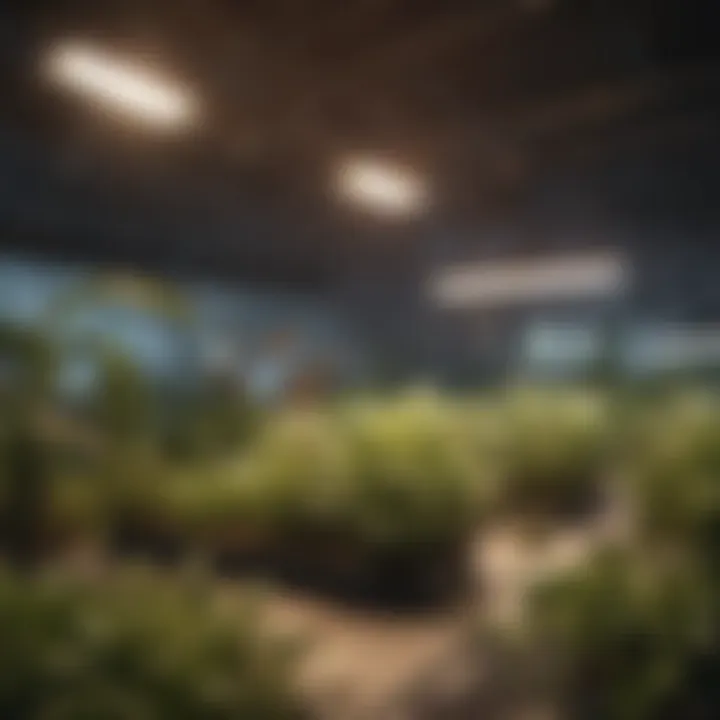
Finally, nutrient delivery systems manage how nutrients are provided to plants, crucial in a hydroponic environment.
Key Characteristic: They can range from simple gravity fed systems to advanced automated systems.
Unique Feature: Automated systems are useful for more precise nutrient control, often customizable according to specific plant needs. But they can also be more complex to install and maintain.
In summary, choosing the right essential equipment for a hydroponics grow tent setup is pivotal. Every piece of equipment plays its part, intertwining to create a nurturing environment that promotes plant growth. Familiarizing yourself with each component enhances your ability to cultivate successfully.
Setting Up the Grow Tent
Setting up a grow tent is like laying the groundwork for a house; it is all about laying out the plans before you build. This stage is pivotal in the hydroponic process. Getting each element right not only eases the growing experience but also influences the growth potential of your plants. A well-planned setup can help optimize space, control climate, and make maintenance easy. With the right tent in the ideal location, you can expect healthy plants and robust yields.
Site Selection and Preparation
Choosing the right site for your grow tent is akin to picking the right spot for a picnic; it can make or break your success. Selecting a location with easy access to electricity and water is essential. The floor should be level to ensure equipment stability.
Consider the following aspects when selecting your site:
- Space: The tent should comfortably fit your designated area without crowding.
- Accessibility: Your plants will need watering and maintenance, so choose a place you can easily reach.
- Light Exposure: If you're using natural light during the day, avoid areas with too much shade.
- Ventilation: A space that allows for air circulation will help in maintaining a stable environment and reducing mold risks.
Once the site is chosen, prepare it by cleaning the surroundings and ensuring there are no obstacles. A clear area is imperative for preventing pests and diseases from easily reaching your plants.
Assembling the Tent
Putting together your grow tent is nearly as straightforward as a puzzle, but it does require attention. Follow the instructions that come with the product meticulously.
- Frame Assembly: Start with the tent frame. Make sure it's stable and secure. Each pipe must be locked well to prevent wobbling.
- Tent Covering: Once the frame is up, drape the tent covering over it, ensuring it's tight. This secures the internal environment.
- Zip it Up: Zippers often need a gentle touch. Make sure they glide smoothly to allow easy access to your plants.
After setting up the frame, kindly double-check that each part is fitted properly. A misaligned corner can lead to light leaks or even damage to the tent itself. It sounds tedious, but ensuring everything is in line will save headaches later.
Installing Lighting and Ventilation
Proper lighting and ventilation are the beating heart of your grow tent. They ensure your plants receive adequate light and airflow, mimicking natural conditions as closely as possible.
- Lighting Setup: Position lights above your plants, allowing for adjustment as they grow. LEDs, for instance, are energy-efficient and can be hung at varying heights. It's usually smart to set them on a timer for consistency.
- Ventilation System: Use fans to facilitate air circulation. This helps regulate temperature and humidity, both essential for healthy plant growth. Look into carbon filters if odor control is a concern. Always ensure ducting isn’t too tight as that inhibits airflow.
"Setting up your grow tent correctly sets the stage for successful plant growth. Placement, assembly, and the right environmental controls make all the difference."
Nutrient Management in Hydroponics
In hydroponics, the soil is substituted with nutrient solutions that provide essential minerals directly to plant roots. Proper nutrient management is crucial; not only does it influence plant growth and health, but it also directly impacts crop yield and quality. If you're diving into hydroponics, getting the nutrient aspect right from the start can mean the difference between flourishing plants and a failed crop. Balancing the right nutrients fosters optimal growth and ensures that your plants can develop healthily, enhancing flavor, aroma, and nutritional value.
Choosing the Right Nutrients
When it comes to nutrient solutions, it’s essential to choose your elements carefully. Plants require a mix of macronutrients like nitrogen, phosphorus, and potassium, along with a slew of micronutrients such as calcium, magnesium, and iron. You might find that different plants have unique nutrient needs, so it's key to research the specific requirements of the crops you're growing.
A thoughtful approach to nutrient selection can significantly affect the outcome of your hydroponic garden.
Some common formulations include:
- General-purpose nutrient solutions designed for a vast range of plants
- Specialized mixes tailored for specific crops, such as leafy greens or fruiting plants
- Organic options that utilize natural ingredients, appealing to those keen on sustainability.
Measuring and Mixing Nutrients
Getting the right doses is essential in hydroponics. Over-fertilizing can lead to nutrient burn, where plants suffer due to excess salts in their systems. Conversely, under-fertilizing means your plants might not get enough to thrive. Thus, precision is key.
- Follow Guidelines: Each nutrient product usually comes with its own mixing instructions. Follow these closely to create the right balance for your crops.
- Use Measurement Tools: A reliable scale and measuring cups can help ensure that you're mixing the correct amounts. It’s advisable to have a pH meter handy because the pH level of your solution can drastically impact nutrient absorption.
- Mixing Sequence: Always add nutrients to water, not the other way around. This ensures a thorough mix and helps prevent clumping.
Monitoring Nutrient Solutions
Once you have your nutrient mix prepared, the next step is monitoring it regularly. Nutrient solutions can change due to various factors, including evaporation, plant uptake, and solution degradation. Regular checks can help maintain levels within the optimal ranges.
- TDS/EC Meters: Total Dissolved Solids (TDS) meters or Electrical Conductivity (EC) meters can gauge the concentration of nutrients in your solution. Keeping the concentration within specified parameters is vital to plant health.
- pH Levels: Monitoring the pH is equally important. Different nutrients are more or less available to plants depending on pH, so using a pH meter to keep your solution between 5.5 and 6.5 is optimal for most crops.
Routine monitoring and adjustments can prevent nutrient deficiencies or toxicities, ensuring that every plant in your hydroponics setup gets what it needs to thrive.
By carefully managing nutrients throughout the growing process, success in hydroponics significantly increases. Whether you're just starting or a seasoned gardener, understanding how to effectively balance and monitor these essential components will be a major game-changer.
Environmental Controls
Environmental controls are a pivotal element in maximizing the success of a hydroponics grow tent setup. They enable growers to create an ideal climate for plants, significantly influencing their health and yield. Let’s delve into some crucial aspects that make environmental controls indispensable for any hydroponic venture.
Temperature and Humidity Regulation
Temperature and humidity regulation is critical in a hydroponic grow tent. Plants thrive in specific temperature ranges, and failing to maintain these can lead to stunted growth or even plant death. Typically, most plants prefer temperatures between 68°F to 77°F during the day with a slight dip at night. Too much heat can cause transpiration to speed up, which might stress the plants. Conversely, lower temperatures can result in poor nutrient uptake.
Controlling humidity is equally essential. High humidity can encourage mold and mildew, while low humidity may lead to transpiration stress. Ideally, maintaining a humidity level around 40% to 60% works wonders. Here are some tools and techniques to regulate these:
- Thermostats: Smart thermostats can adjust temperatures after monitoring.
- Humidifiers/Dehumidifiers: Depending on your specific conditions, these devices help maintain humidity levels.
- Fans: Air circulation is critical. Oscillating fans can help prevent hot spots and ensure even temperature.
"In the world of hydroponics, a stable environment is the foundation for healthy plants."
Using these techniques can mean the difference between bountiful harvests and disappointing results. Monitoring tools like hygrometers and thermometers provide real-time data, allowing for swift adjustments to protect the crops.
Light Cycles for Optimal Growth
The right light cycle can greatly affect plant growth and development in a hydroponics setup. Plants utilize light for photosynthesis, and the duration, intensity, and quality of light are all significant factors. Different crops require different light cycles. For instance, most leafy greens thrive under about 12 to 16 hours of light daily, while fruiting plants like tomatoes might require longer periods, often up to 18 hours.
Setting up your grow tent with adjustable lighting can benefit various growth stages:
- Seedling Stage: Use softer light for seedlings to prevent stress.
- Vegging Stage: Blue-spectrum lights in this phase promote healthy leaf growth.
- Flowering/Fruiting Stage: Switching to red-spectrum lighting can boost fruit production.
Timing is just as important as the lighting itself. Implementing a timer to automate light cycles simplifies management. Consistency in light exposure can promote stronger growth patterns and healthier plants overall.
Maximizing light efficiency also entails positioning lights correctly:
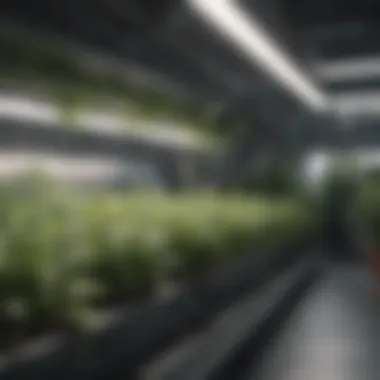
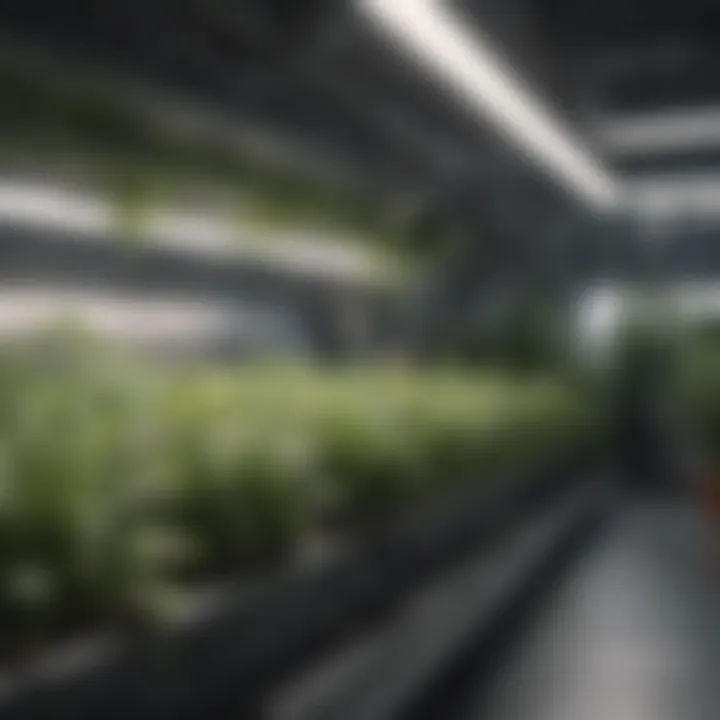
- Distance from Plants: Keeping lights at the optimal distance to avoid burning leaves.
- Reflective Materials: Using mylar or similar materials inside the tent can improve light distribution.
With proper lighting control, the plants in your grow tent can receive the best possible environment, fostering growth that will surely pay off. By mastering these controls, you can ensure a thriving hydroponic oasis!
Remember, the success of your hydroponic system hinges not just on the plants themselves but equally on the environment in which they grow.
Plant Selection for Hydroponics
Selecting the right plants for a hydroponics grow tent is not just a matter of picking the prettiest flowers or the tastiest vegetables. It’s an intricate dance that involves understanding the growth conditions these plants require, their growth cycles, and how they perform in a soil-free environment. By choosing the right crops, one can maximize yield and ensure healthy plant development in a controlled setting.
Best Crops for Beginners
If you're just starting out with hydroponics, it’s sensible to choose crops that are forgiving and easy to manage. Here are some optimal choices:
- Lettuce: This leafy green grows rapidly and doesn’t require a lot of nutrients, making it perfect for novices.
- Herbs: Varieties such as basil, mint, and parsley thrive in hydroponic systems. They add flavor to dishes and are relatively low-maintenance.
- Radishes: Fast-growing and uncomplicated, radishes can sprout in as little as three to four weeks.
- Spinach: Known for its nutritional benefits, spinach grows quickly and can be harvested multiple times.
These plants not only yield results fairly quickly but also let beginners get accustomed to monitoring pH levels, nutrient solutions, and light requirements without unnecessary stress.
Tip: Start small with a few different plants before expanding your garden. A hands-on approach is the best teacher.
Advanced Crop Choices
Once you've got the hang of basic crops, you might want to venture into more challenging varieties. These plants typically require a bit more finesse but can lead to substantial rewards:
- Tomatoes: With characteristics that demand specific light cycles and nutrients, the satisfaction of harvesting your own tomatoes is worth the extra effort.
- Cucumbers: These need support structures as they grow and must be monitored for pests and diseases, but they can produce a bountiful yield.
- Peppers: Both sweet and hot varieties can flourish under the right conditions, and they tend to appreciate stable environments in hydroponics.
- Strawberries: While they can be trickier, growing strawberries hydroponically can yield delicious results and ultimately proves rewarding.
When selecting advanced crops, it’s crucial to study their individual requirements closely. This means understanding their light, space, and nutrient needs, which might differ significantly from beginner friendly varieties.
Monitoring and Maintenance
Monitoring and maintenance hold a vital role in the overall success of a hydroponics grow tent setup. The controlled environment that hydroponics provides facilitates plant growth, but it is the diligence in monitoring and maintenance that ensures optimal conditions for that growth. Plants, while resilient, are sensitive to changes. Everything from nutrient levels to environmental conditions must be closely observed to prevent issues before they manifest. Moreover, consistent monitoring helps maintain balance in the tent, so plants can thrive, which is essential not just for maximizing yield but for sustaining plant health over time.
Routine Checks and Adjustments
Routine checks and adjustments form the backbone of effective monitoring and maintenance. It’s not enough to set up your grow tent, fill it with plants, and walk away. Here are some key aspects to focus on during your check-ins:
- Check nutrient levels: Regularly measuring the pH and electrical conductivity (EC) of the nutrient solution is crucial. A deviation could signal that adjustments are needed. Nutrient imbalances can lead to poor plant growth or even loss of crops.
- Inspect plants for any signs of stress or disease. Yellowing leaves or wilting plants could indicate issues like root rot or nutrient deficiencies. Early detection can make all the difference.
- Ventilation assessments: Ensure your fans and filters are working properly. Lack of airflow can create hot spots or stale air, which is a breeding ground for mold and pests.
- Lighting inspections: Check that all light fixtures are operational. A broken bulb can lead to uneven light distribution, causing some plants to stretch and others to stagnate.
Performing these checks on a weekly basis or even more frequently, depending on plant growth rates and environmental variables, can save you a world of trouble down the line.
Sometimes it helps to keep a logbook where you can jot down observations and changes. This not only aids in staying organized but also helps identify patterns over time which, in their own right, can reveal potential problems before they escalate.
Troubleshooting Common Issues
Inevitably, as with any cultivation method, problems can arise. Knowing how to troubleshoot effectively is crucial in mitigating issues quickly:
- Nutrient Burn: If you notice browning leaf tips, you might be over-fertilizing. Diluting your nutrient solution or flushing plants with fresh water can help alleviate this problem.
- Powdery Mildew: This fungal disease can thrive in humid conditions. Ensuring your tent has proper air circulation and, if necessary, raising the temperature slightly can help. Organic fungicides are another route, but be sure to choose ones safe for edible crops.
- Inconsistent Growth: If some plants are thriving while others are not, consider environmental factors such as light distribution or airflow. Adjusting the position of your lights or rearranging plants can help achieve a more uniform growth environment.
- Pest Invasion: Common pests like aphids or spider mites can pose a significant threat. Regular inspections can catch infestations early. Neem oil or insecticidal soap can combat pests but should be used cautiously to avoid harming beneficial insects.
"The best medicine is preventive care; an ounce of prevention is worth a pound of cure." This adage rings true, especially in the world of hydroponics. Diligence and foresight can protect your crops and ensure a bountiful harvest.
In summary, effective monitoring and maintenance surrounding a hydroponics grow tent setup requires commitment but can lead to rewarding outcomes. Adopting a routine, staying alert to plants’ needs, and addressing issues promptly can pave the way for a successful hydroponic venture.
Sustainability in Hydroponics
In today’s world, sustainability holds considerable weight, especially in agriculture. As we juggle the demands of feeding a growing population and dealing with climate change, hydroponics has emerged as a beacon of hope. When done correctly, hydroponics can significantly minimize resource usage while maintaining high levels of productivity. This section sheds light on why sustainability in hydroponics is pivotal and how it integrates within the broader context of modern farming.
Resource Efficiency
Resource efficiency refers to the prudent use of materials, time, and energy in any setting. In hydroponics, this translates into optimizing inputs while maximizing outputs. One of the most striking examples of resource efficiency is in water usage.
Traditional farming often wastes a substantial amount of water due to evaporation, runoff, and inefficient irrigation techniques. In contrast, hydroponic systems can use up to 90% less water. Here’s how:
- Recirculation: Water is cycled through the system, allowing roots to absorb what they need before the excess is returned to the reservoir.
- Closed-Loop Systems: These systems help in capturing and reusing water that would otherwise be wasted.
Ultimately, by employing these techniques, growers not only save resources but also cut down on costs over time. Furthermore, less water usage helps keep the local water table levels stable, a critical issue in drought-prone areas.
Reducing Environmental Impact
Hydroponics isn't just about maximizing yields; it plays a significant role in lowering the environmental footprint of agriculture. Especially in urban settings where land is scarce and air quality is declining, hydroponics offers a sustainable alternative. Here are key ways that hydroponic setups can reduce environmental impact:
- No Need for Soil: Since hydroponics relies on nutrient solutions rather than soil, the problems of soil degradation and pest infestations are virtually eliminated. This means fewer pesticides and fertilizers are needed, which often run off into local waterways and can cause ecological damage.
- Local Production: Hydroponic systems can be set up almost anywhere – from rooftops to basements. This localization reduces food miles, which is how far food travels from production to consumption. Less transportation means fewer emissions.
- Less Land Use: Hydroponics allows for vertical farming, which makes it possible to grow in smaller spaces but still produce large quantities of food. Cultivating in layers rather than sprawling fields reduces the need to encroach upon natural habitats.
- Energy Efficiency: Many modern hydroponic systems use energy-efficient technologies. By synchronizing growth cycles with light availability and climate needs, growers can minimize energy consumption.
"Hydroponics can redefine how we perceive agriculture by placing emphasis on sustainability and resource management."
Ending on Hydroponics Grow Tent Setup
When it comes to hydroponics grow tent setup, reaching the finish line is far from just packing up equipment. It symbolizes the culmination of a well-thought-out journey into sustainable agriculture. This section serves as a critical reflection on why these setups are paving paths in modern farming amidst a backdrop of growing environmental concerns and food security issues.
Harnessing Technology for Better Yields
Hydroponic systems, particularly those utilizing grow tents, leverage technology to grow plants without soil. This method not only conserves water but also maximizes space and increases yields compared to traditional farming. Employing a controlled environment allows for precise manipulation of variables like light, humidity, and nutrient levels, cultivating an ideal backdrop for robust plant development. In essence, what you are setting up is a miniature ecosystem dependent on careful management and observation - a distinctive advantage for urban farmers and enthusiasts alike.
Economic Viability
Another cornerstone of hydroponics setups is their economic viability. Investing in hydroponic systems can yield faster returns compared to conventional agricultural practices. You can effectively grow crops year-round, especially when aided by grow tents that enhance environmental controls. The potential to grow high-value crops, like herbs or exotic fruits, can provide not just sustenance but also supplementary income streams.
"With hydroponics, one seed becomes a bountiful harvest, even in small spaces."
In many urban situations where soil quality is poor or land is scarce, hydroponics can literally turn the tables. It opens doors for individuals who want to engage in farming, whether for personal or commercial use.
Considerations for Successful Setup
- Proper management of environmental factors is essential; this includes ensuring adequate lighting, ventilation, and nutrient supply.
- Monitor plants regularly to catch potential issues before they escalate, maintaining the health of your investment.
- Be prepared to adapt to evolving technologies and methods in hydroponics, as innovations emerge with increasing rapidity in this field.
Summarizing Key Points
As we wrap up the detailed overview of a hydroponics grow tent setup, let’s recap the significant elements discussed throughout the article:
- Understanding Hydroponics: The revolutionary method of growing plants without soil has proven advantages over traditional farming methods, including water conservation and better-controlled conditions.
- Grow Tent Importance: A grow tent serves to regulate the cultivation environment, making it an indispensable tool in hydroponic setups.
- Essential Equipment: Lighting, ventilation systems, and hydroponic components were highlighted as crucial for successful plant growth and management.
- Nutrient and Environmental Management: Strategic nutrient choices and environmental controls play a vital role in ensuring robust plant health.
- Sustainability: Hydroponics not only offers efficient resource usage but also reduces the environmental footprint of farming practices.
By recognizing these points, growers will be better equipped to embark on their own hydroponic ventures, promoting sustainable practices in agriculture.
Future Considerations
Looking ahead, there are several key considerations for those engaging in hydroponics grow tent setups.
- Technological Advancements: As technology continues to evolve, keeping abreast of latest hydroponic systems and equipment can greatly enhance outcomes. Innovations such as automated nutrient mixing or advanced LED grow lights can provide significant advantages.
- Sustainability Practices: Being mindful of eco-friendly practices, such as using organic nutrients and recycling water, can further improve the sustainability of hydroponic setups.
- Community Engagement: Building networks with fellow hydroponics enthusiasts for sharing insights and best practices can enrich your knowledge base, leading to better crop yields.
- Policy Impacts: Stay aware of agricultural policies and programs promoting urban farming initiatives, as they may provide additional resources or funding opportunities.
These future considerations not only enhance the personal experience of cultivating plants but also contribute to the broader context of sustainable agricultural practices. In essence, the journey of hydroponics grow tent setup is just beginning.



